One-of-a-kind Ownership at The Black Bull
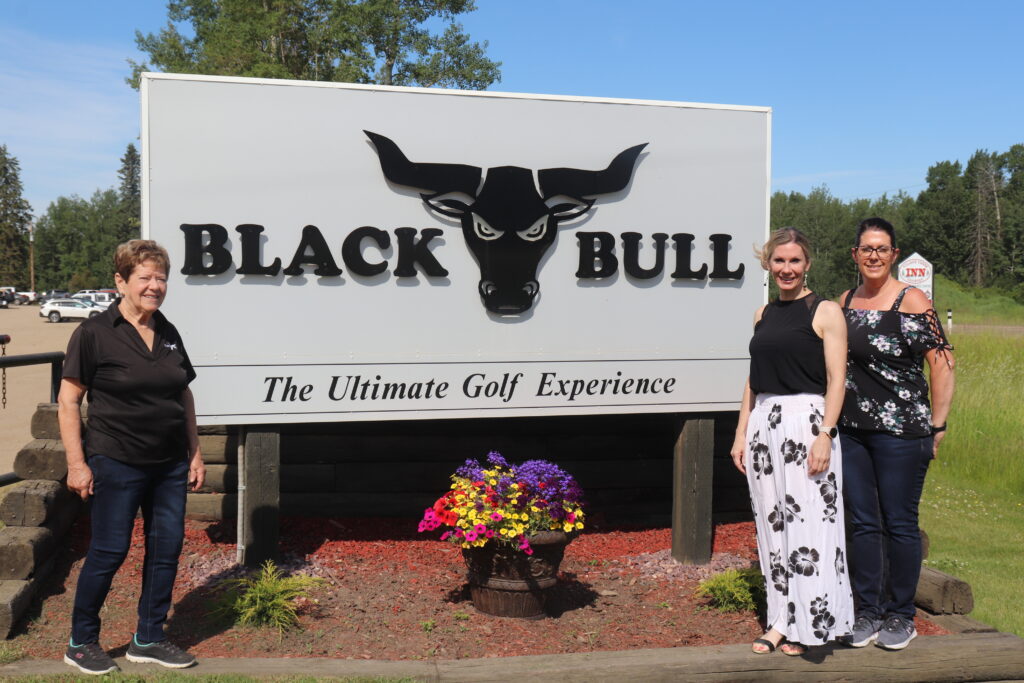
Alberta Golf (Ma-Me-O Beach) – The Black Bull Golf Resort in Ma-Me-O Beach, south of Edmonton, has been operated by one family for 3 generations and is currently the only fully female owned and run golf course in Alberta. The course is currently owned by Judy Wylie and her daughter Patricia O’Connor.

Judy, Patricia and Cathy
The course opened in 1971 with Patricia’s grandfather and uncle as the co-owners. Judy became the sole owner in 1998 with Patricia coming on board as co-owner in 2009.
“I think that’s something to hang your hat on for sure,” O’Connor admitted. “To be a solely female owned and operated course with the largest leagues in the area that other courses have emulated is a great feeling.”
The Black Bull is a busy place with men’s and ladies leagues with 100 players each and 4 generations of the family have been involved. Patricia has 2 daughters who work at the course and her sister Cathy has 4 daughters.
“She’s a teacher by trade and teaches in the area during the school year and she works at the club in the summer and we’d be lost without her,” O’Connor admitted. “My Sister Cathy has 4 daughters, 2 are quite little but the other 2 daughters have worked at the club as well. And my uncle’s son and daughter have also worked here. It truly is a family affair.”
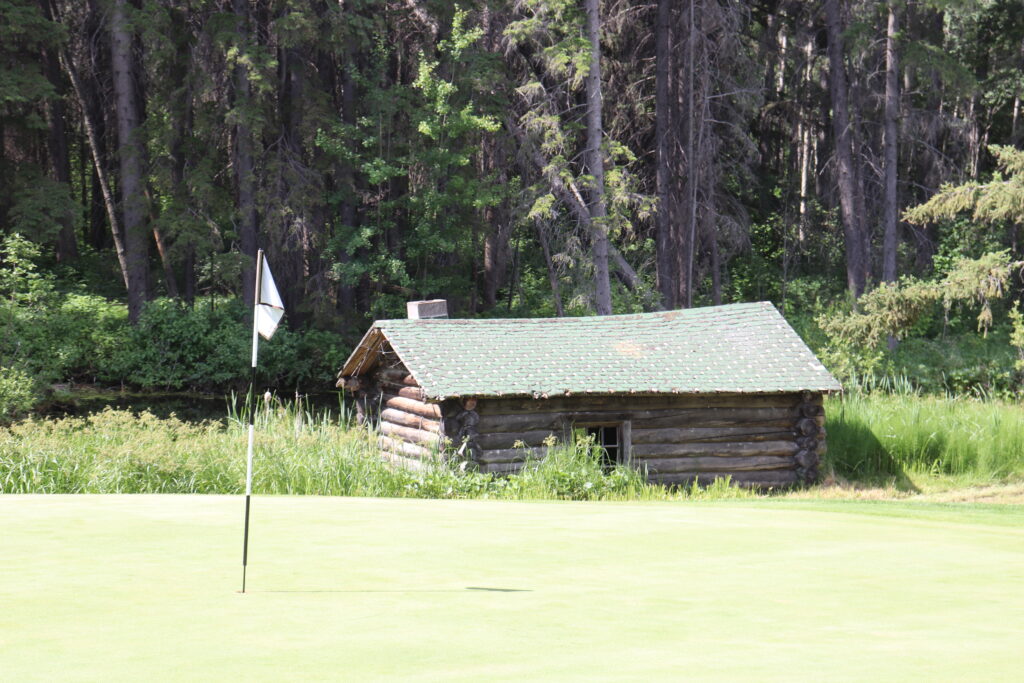
O’Connor takes great pride in the country atmosphere they’ve created.
“The coffee pot is always on, we typically know people’s names and they’re always greeted with a welcoming smile and how you feel is more important than how you look.”
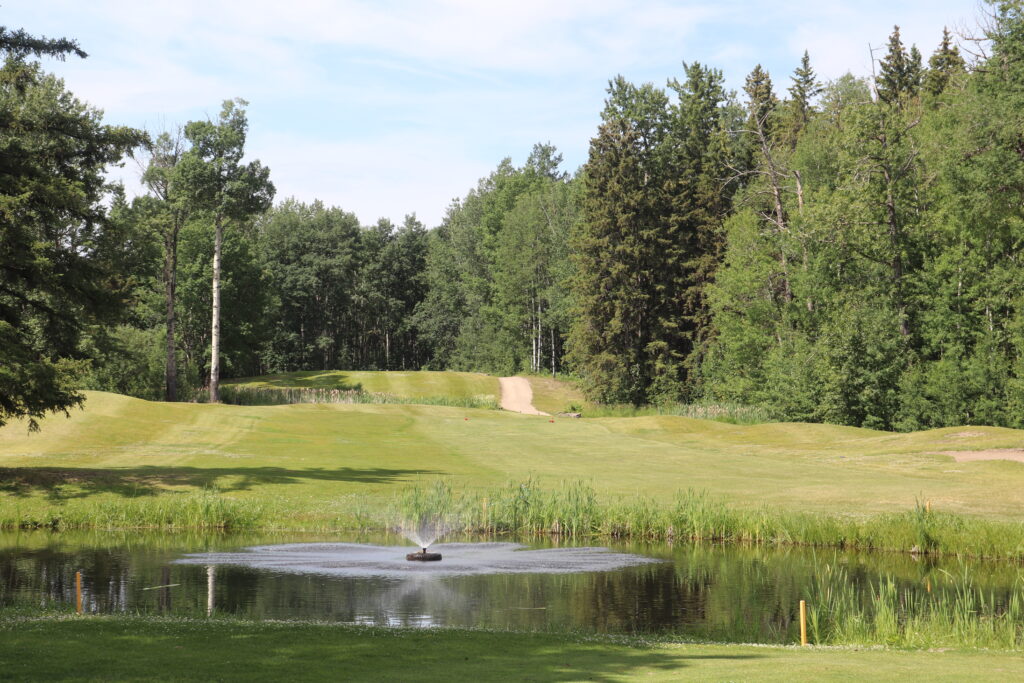
WATCH VIDEO INTERVIEW WITH CO-OWNER PATRICIA O’CONNOR
O’Connor and her extended family all live within seconds of the course.
“All anyone needs to do to discover why we are in love with Black Bull is either be out first thing in the morning which I personally never am, I’m not a morning person,” O’Connor admitted. “I like to come late at night when you have the place all to yourself, there is something so peaceful and so beautiful and you have it to yourself.”
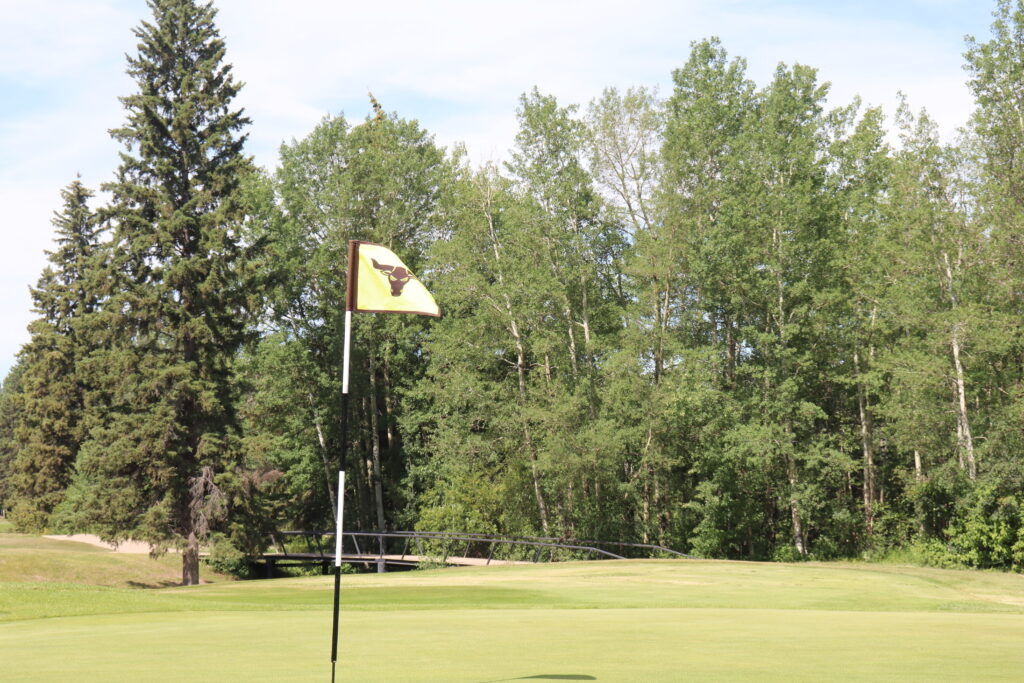
The rest of time the place is very busy and very affordable.
There’s a senior special every Tuesday and Thursday for aged 50 and over which gets you 18 holes with a cart for $45. And the most expensive time on weekends with a cart is still only $90.
There are 7 new tee box options now after the course went through the re-rating process with Alberta Golf and helped introduce some combo tees.
‘For the people who were traditionally intimidated by Black Bull and it’s difficulty and tightness there are now 7 different yardage combinations,” O’Connor said. “That’s made it a little easier and more female friendly as well. “
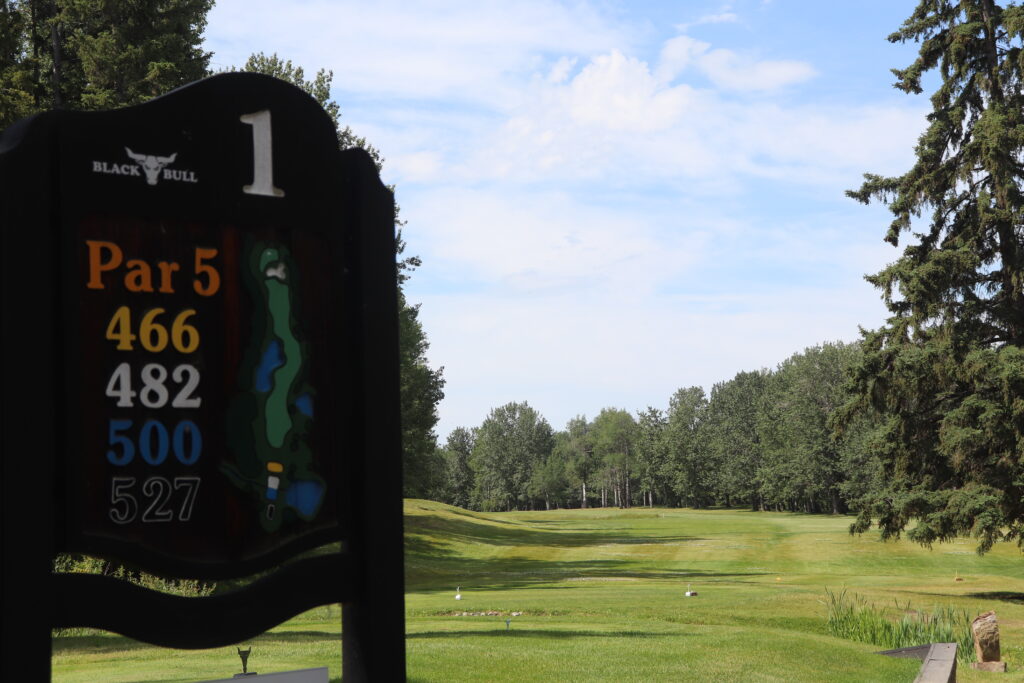
Quite a few members are from Edmonton and Calgary, some from Red Deer. It’s known as a tournament course that hosts a lot of scrambles but mostly it’s known for being one of the toughest tracks in Alberta.
“The Black Bull can give you a real butt kicking,” O’Connor said. “Anyone who thinks they’re tough enough to tame the bull and wants a true challenge should come here.”
David Schultz back in Paradise
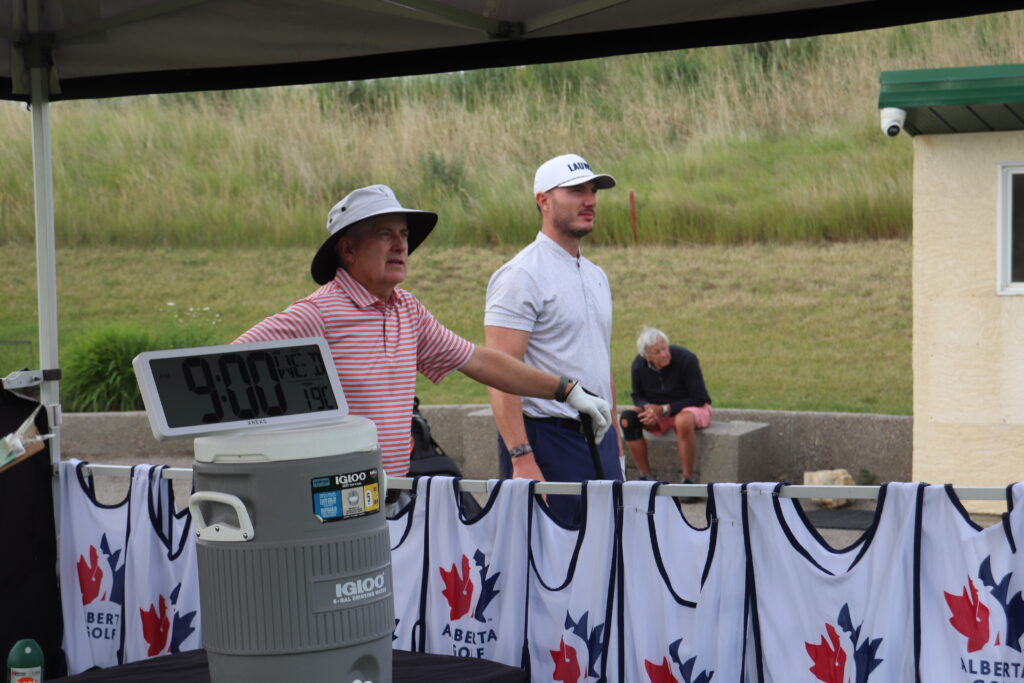
Alberta Golf (Lethbridge) – The 113th Alberta Men’s Amateur Championship is being held this week at Paradise Canyon Golf Resort in Lethbridge. It’s the first time since 1993 that Paradise Canyon has been the host and the only player in the field to play in both events is 67-year-old David Schultz of Calgary. Schultz is the recent winner of the 2023 and 2024 Alberta Men’s Super Senior Championship and he also won the 2024 Alberta Men’s Senior Championship to qualify for this event. What did Schultz think when Paradise Canyon was announced as the host for this event in 2025?
“I wasn’t thinking too much until I won the Alberta Men’s Senior Championship and I got an exemption,” Schultz explained. “I thought why not, I’ll give it one last farewell tour and play with the kids and see what happens.”
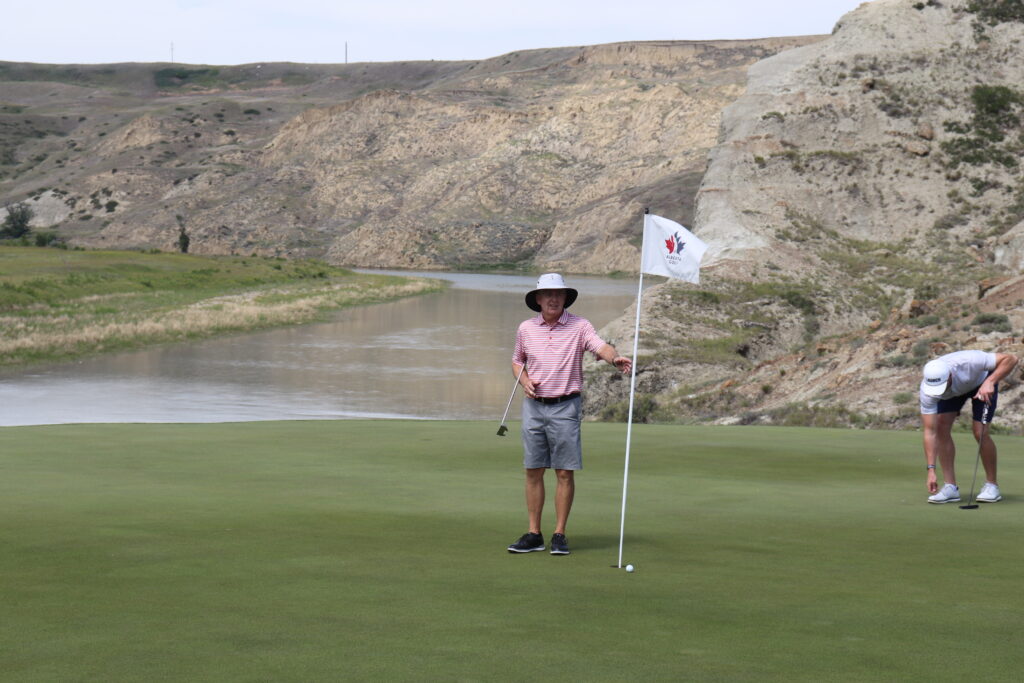
Stepping on the property this week, and shooting a tidy 3-under par 68 in a practice round, Schultz didn’t think much had changed with the dramatic layout in the canyons.
“It was a beautiful place, we came down here in 1993 knowing it was a couple years old and it was great, a beautiful golf course. We had a lot of fun, a lot of good play that week,” Schultz explained. “I shot 70 on the final day to sneak into 2nd place but no one was catching Darryl James who blew the field away that week and won by 7 strokes. To be the only player in the field coming back here after 32 years, I’m really enjoying it.”
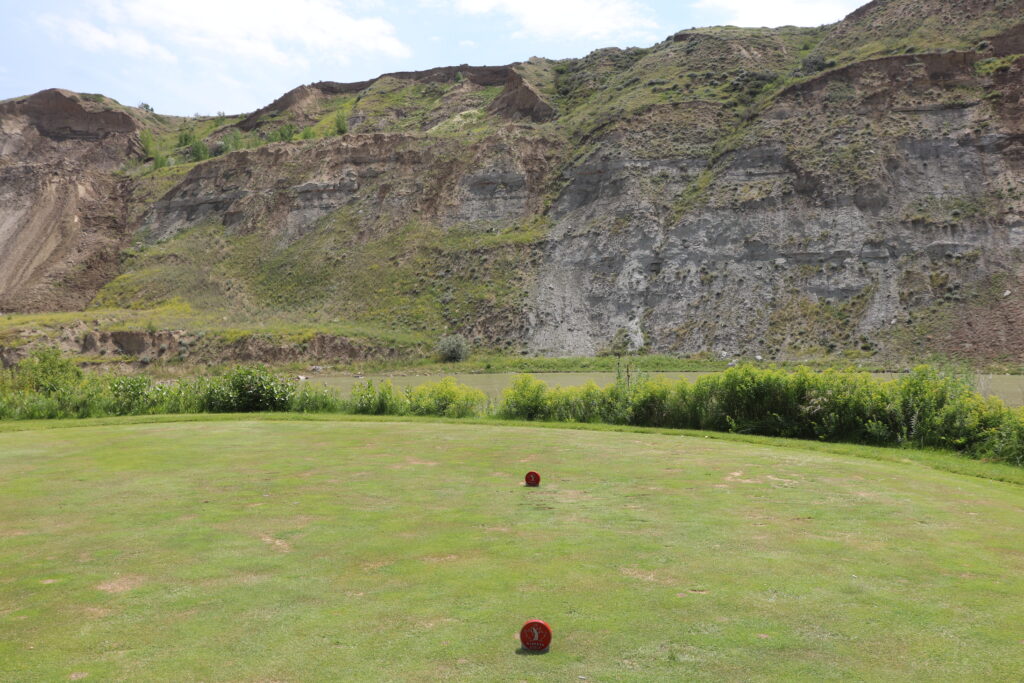
In 1993 no one was catching Darryl James for the title, but there were 3 more spots on the Willingdon Cup for Team Alberta up for grabs. Schultz came 2nd and made the team along with Keith Whitecotton. Home course player Jamie Freel outdueled the likes of Harold Pasechnik and 64-year-old legend Bob Wylie to make the team.
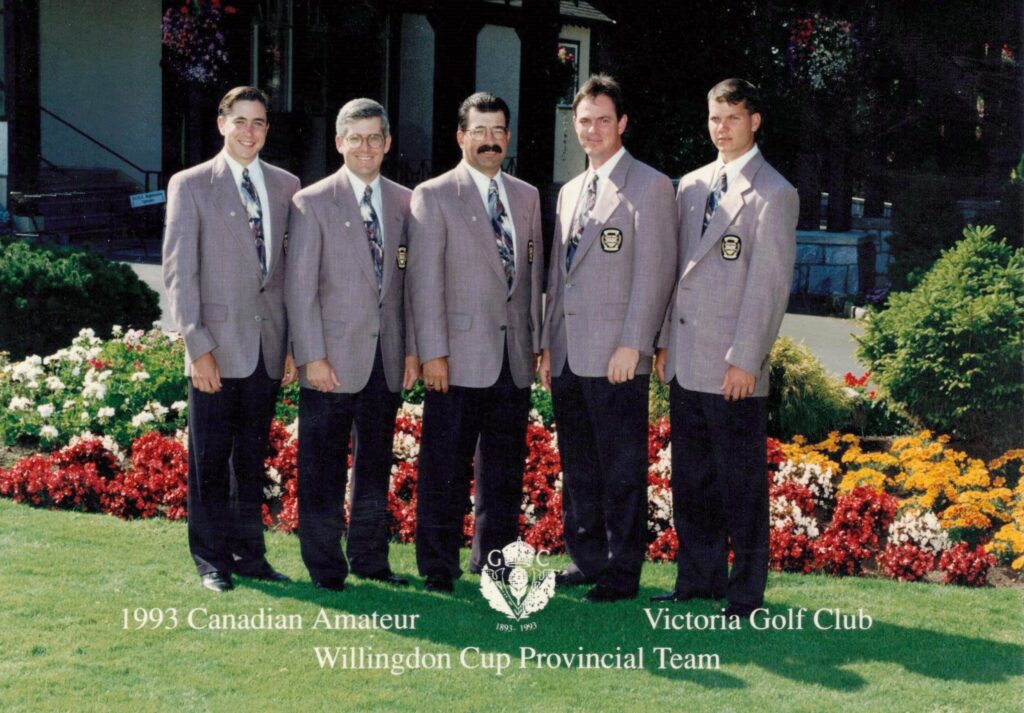
“Coming in 2nd to make the Willingdon Cup team was a thrill,” Schultz said. “Myself, Darryl James, Keith Whitecotton and Jamie Freel went to Victoria and won the Willingdon Cup so it was a great year.”
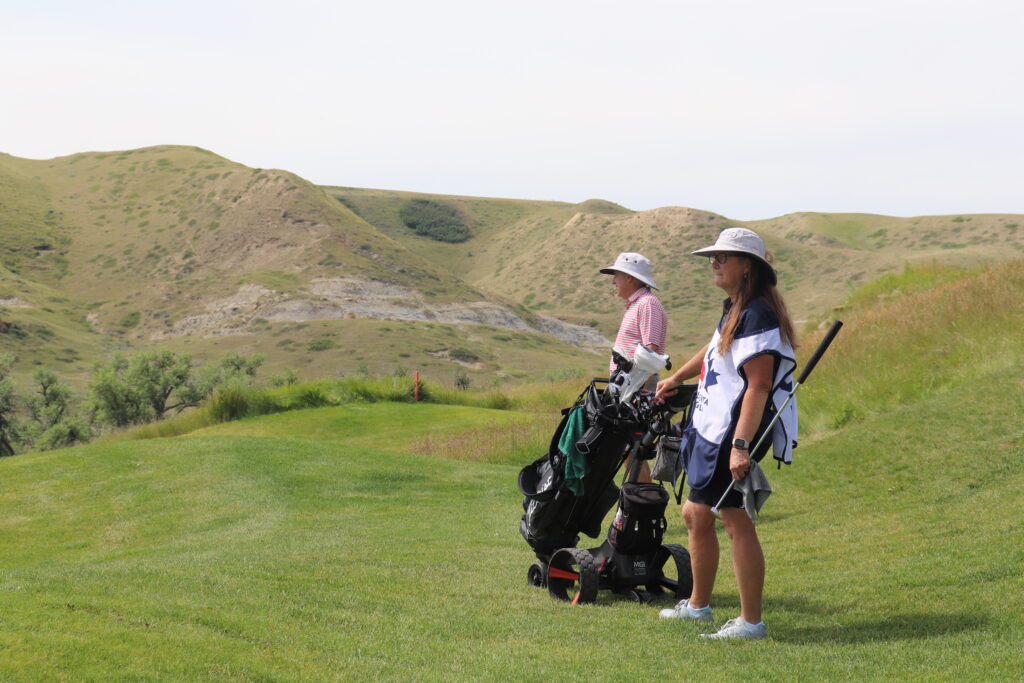
David and his wife Karen will be celebrating their 40th wedding anniversary this November. Karen is David’s caddie this week and almost every week the past 40 years except at Paradise Canyon in 1993 when their kids were very young.
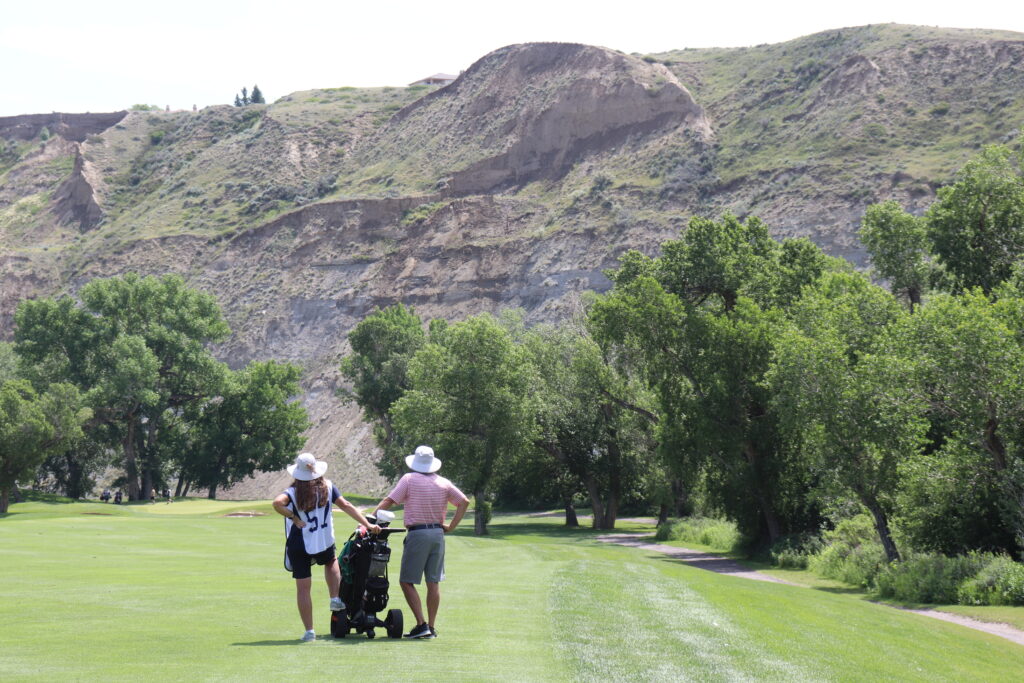
“Oh it’s great to have that support, it’s good she still puts up with me, I’m not always the best on a golf course like any golfer,” Schultz admitted. “We’ve had a lot of good trips together, we’ve travelled the world, I’ve played so many tournaments and she’s always caddied so it’s been a lot of fun.”
Karen had a front row seat to David shooting an even par 71 in round 1 and says she always loves being the caddie and watching great golf.
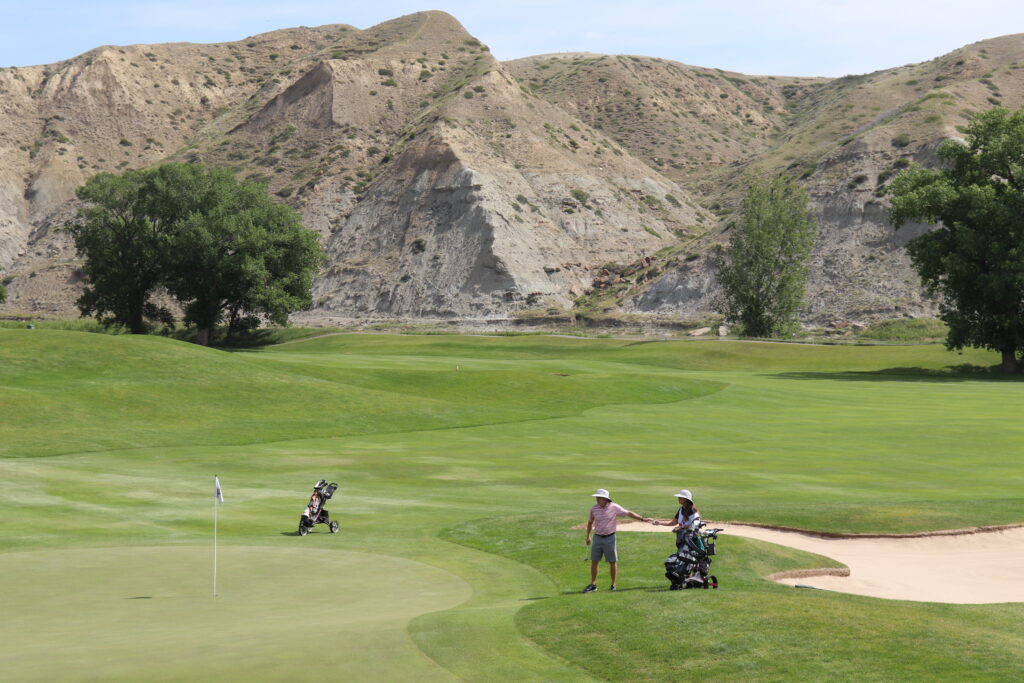
“David’s 71 today was solid and outplaying some of the young kids? I think that’s fun and to be honest fairly normal,” Karen chuckled. “I like the ups and downs of it all, I think it’s just fun to watch, it’s exciting, I like watching all the good players play,”
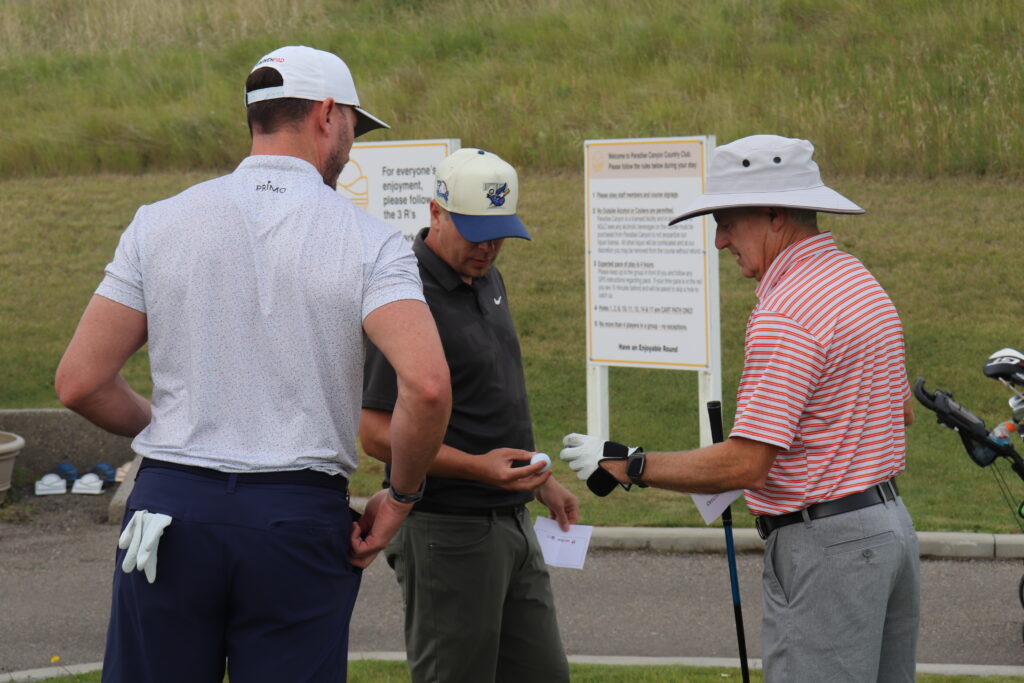
Jesse Galvon, Ryan Werre and David Schultz
Turns out Schultz is indeed hanging in with the kids just fine, shooting an opening round even par 71. An amazing story that can only be topped if he somehow shoots his age of 67 in round 2.
“It was solid, I made a couple good up and downs, had one lucky break on 18,” Schultz said. “Could have made a couple more putts, but overall pretty solid. The ball and the course don’t know how old I am.”
As for how Schultz’s game has changed over the past 32 years?
“I don’t hit it like the kids but I know where it’s going,” Schultz said. “I’m probably straighter now than I’ve ever been in my career which certainly helps, and I still have the competitive urge, it’s a lot of fun.”
WATCH VIDEO INTERVIEW WITH DAVID AND KAREN SCHULTZ
Alberta’s Best 9-Hole Courses

True, golf is an 18-hole game. It’s the benchmark. The norm. Probably always will be. However, as our culture continues to evolve (time is of the essence, folks!), the popularity of state-of-the-art driving ranges, putting courses, and par-3 courses continues to grow. And those lovely little 9-hole courses? Yes, those are trending in a positive direction! And if the short-and-snappy 9-hole game is your speed, you’re in luck! Alberta is home to numerous 9-hole courses where good times and great golf is par for the course.
Not surprisingly, you can find 9-hole courses sprinkled throughout the province. While upscale 9-hole courses do exist, the vast majority are grassroots establishments where strict dress codes, high green fees, GPS-equipped carts, and so forth, will be hard to come by. In terms of what you will find? Affordable green fees, relaxed atmospheres, good turf conditions, and all-are-welcome mantras.
So, what are the best 9-hole courses in each region? I’d start with these.
Southern Alberta
Pincher Creek Golf Club – A personal favourite, the Pincher Creek Golf Club is a rural Alberta gem. Located on the southern edge of town, the sublime mountain views, the “gettable” par-5s, the rolling fairways, the two excellent par-3s, the quaint little clubhouse; it all adds up to a fantastic half-day of golf.

LivingStone Golf Course – The Goodwin family designed LivingStone Golf Course catches a lot of people by surprise. The tagline – “Where Golf Meets The Wilderness” – is an apt descriptor. Tucked away in a valley just twenty minutes west of Calgary, the bunker less course is loaded with character, including exciting elevation changes and wonderful mountain views.

Fort Macleod Golf Club – This list wouldn’t be complete without mentioning the lovely little Fort Macleod Golf Club. Established in 1890, this is the oldest golf course in Western Canada. Rich with history (you may encounter ancient wagon ruts, buffalo bones, and ammunition shells from the old rifle range at the fort), the tricky, tree-lined course is full of charms.

Central Alberta
Mannville Riverview Golf Course & RV Resort – Located in the Vermillion River Valley just north of Mannville (not far from the Saskatchewan border), this scenic 9-holer is, without a doubt, one of the undiscovered jewels in the province. A remote feel with first-rate holes and an awesome RV park? Sign me up.

Pineridge Golf Resort – Situated on the western shore of Lake Wabamun, Pineridge is another RV-friendly golf resort with a unique twist – it’s Alberta’s first 12-holer! While the scenic course is undoubtedly the star of the show, the extra amenities – the clubhouse, recreation center, lake, sports lounge, and much more – make this one of the top golf & RV outposts in the province.

Two Hills Lions Golf & Country Club – Designed by Alberta architect Sid Puddicombe & Associates, the scenic Two Hills track is yet another Alberta 9-holer that doesn’t get its due. The course, which is located on the west side of tiny Two Hills (approximately an hour and a half east of Edmonton), has links-like characteristics and features bold shaping, plenty of bunkers, and gently rolling fairways.

Northern Alberta
Hidden Valley Golf Course – Sitting snug in a beautiful valley just south of Fawcett, Hidden Valley ticks all the boxes for a memorable 9-hole experience. The 3,000-yard, par-36 course offers beautiful scenery, fun and challenging holes, nice conditioning, a great little clubhouse, and tidy RV sites for golfers who want to hunker down for the long haul.

River Stone GC – Boasting one of the longest golf holes in Canada – the 658-yard 9th – River Stone is another better-than-you-think course that’s routed in a remote area along the Smoky River near Grande Prairie. With plenty of elevation change and stunning scenery throughout, you’ll be singing its praises the moment you arrive.

Smoky Lake GC – The moniker “hidden gem” is overused. But it’s the most accurate descriptor I can think of for the super-scenic Smoky Lake GC. The course, which features 9 wonderful holes that meander through the boreal forest, is known for its great conditioning and gorgeous setting in the White Earth Creek Valley.
True, there are many more 9-hole courses in Alberta that merit a visit. And, trust me, I’ve got a few on my radar that I plan to visit soon. A heavenly half-round with a pint on the patio after play? Count me in.

Get Ready For Golf Season With 5 At Home Exercises

Get ready for the golf season with Jordan Jeske and Projct Golf, as he provides golfers with 5 easy exercises they can do at home with minimal equipment! Click the Youtube video below to watch.
If you’re looking for more information on Projct Golf, visit their website which is linked below.
An Inside Look At A Lesson With A PGA of Alberta Professional

2025 Host Club Spotlight: River Spirit Golf Club

Last year, River Spirit Golf Club played host to Alberta Golf for the first time since the Alberta Match Play in 2019. The course saw the best female golfers in the province competing for one of the oldest and most prestigious trophies in amateur golf. In 2025, River Spirit will play host again for one of the oldest and one of the newest trophies at Alberta Golf, as it hosts the 89th Alberta Open Championship on August 11-13.
River Spirit Golf Club underwent a rebrand in recent years, trying to put a new spin on the game of golf. Their focus was to separate themselves from the traditional game and focus on creating community, uniqueness, integrity, and most importantly growth within the game of golf. Their 27-hole facility, paired with the scenery at the course, and their charming clubhouse allows everyday patrons to relax and unwind at this one of a kind facility. The course is no cakewalk, and will challenge the best golfers in the province with tight tee shots, a course yardage close to 7,000 yards, and a course rating of over 73.0 from the tips. While the course difficulty is one of the reasons to go back to River Spirit, their focus on growth within the game makes it the perfect host for the 89th Alberta Open Championship.
The Alberta Open Championship has been around since 1912 but has had plenty of cancellations throughout its history including sponsorship issues, World War 2, and low registration numbers. Despite this ‘The Open’ has remained a staple for the best male professional and amateur golfers to prove themselves, with the likes of Stan Leonard, Moe Norman, Kirk Triplett, and Wes Heffernan all competing for the trophy. With its storied history, 2025 marks the start of a new chapter with the addition of a professional and amateur women’s division, along with the women’s open component. Females with a Handicap Index of 10.0 or lower will now be able to compete without qualifying, with 40 spots being reserved for the best female golfers in the province. The professionals will be competing for a yet to be announced purse, while amateurs will be competing for a chance to play in the PNGA Women’s Amateur in 2026.
With River Spirit as the host and the new additions to the Alberta Open, the 89th playing of this prestigious event will be a new chapter as Alberta Golf and River Spirit continue to focus on growing the game of golf, while preserving the important traditions that lay as foundations for the sport.
Q&A with Alberta Sports and Recreation Association for the Blind

For International Day of Disability, Alberta Golf wants to showcase the work that’s being done by other organizations in the sports and recreation space. This is where the Alberta Sports and Recreation Association for the Blind (ASRAB) comes in. ASRAB supports Albertans, who are visually impaired, and want to live physically active lives and participate in competitive support programs.
The association runs a variety of programs each year, many of them introductory, in a variety of sports helping these athletes learn the basics of each sport, while promoting physical literacy. They’re most known for their involvement with Goalball which is a Paralympic Sport. ASRAB has been offering try-it golf programming for over 10 years, and it has since grown to almost all their major centres.
Please enjoy this Question and Answer with ASRAB’s Executive Director, Linda MacPhail!
What is ASRAB? What is the mission of the organization? What kind of programs do you run?
ASRAB is the Alberta Sports and Recreation Association for the Blind. The association’s mission is to support Albertan’s who are visually impaired with living active lifestyles and participate in sports. So, we work with children and teach them fundamental movement skills and introduce them to a wide variety of sports. We have a “Movement for Me” session going on right now where we teach the kids skills such as jumping, hopping, throwing and striking, so they develop some of those basic skills, and then take that into different sports. We’re working with educators to create modules for when children are in physical education classes, and assist the teacher or educator can work with the child and include them in a meaningful way in learning new sports skills. We also offer a wide range of recreational activities to expose participants to as many opportunities as we can, to see what they like and find a niche for them to be physically active. So, in a year we’ll have any number of different activities, anything we can think up that we can adapt for our members and introduce them to different sports.
Goalball is the sport that we have responsibility for, and the one activity that we support recreationally and competitively. Goalball is a Paralympic sport. It was created after the Second World War to keep soldiers that had lost their vision physically active in a competitive environment. So goalball is the sport we do from playground to podium. We teach children Goalball, we have youth Goalball programs, junior teams and senior teams, coaches and officials. Both of our Provincial Coaches were Paralympians, and one (Trent Farebrother) is the head coach for the women’s national team coach, and spent this last summer in Paris coaching the Canadian Women at the Paralympic Games.
How did ASRAB start and how has the association grown since then?
We’re coming up to our 50th anniversary. It was a swim coach, Lorna Snow, who was working with a child with vision impairment in the pool, and was looking for other ways to support children with low vision develop physical literacy. She and other like-minded individuals started the association. From there we’ve grown to where ASRAB is currently active with seven major centres: Fort McMurray, Grande Prairie, Edmonton, Red Deer, Calgary, Lethbridge, and Medicine Hat.
Going back to the first question, it sounds like ASRAB runs a lot of introductory programming, besides Goalball are there any other sports that the association has a competitive pathway for?
The only sport that we have the technical expertise in to support high performance programming is goalball. We’re experts at helping adapt sports and being inclusive and teaching sports but if somebody starts a sport and they become more adept at it and want to pursue it we’re here help get them connected with the correct people.
Do you mind listing some of the programs that you ran this year?
As I said we’re now in seven different centres and they all offer different programming based on availability, but we run a physical literacy and fundamental movement skills for children program called “Movement For Me”, we’ve been working on educational and support programs for educators, and of course our Goalball programs.
Some of our introductory sport programming includes golf, curling, gymnastics, skating, hockey, snowshoeing, summer camps, walking Clubs, hiking, canoeing, horseback riding, cycling, tennis, lacrosse, basketball, volleyball. All our programming duration varies for each sport from one-day to ongoing programs as well.
How did your organization begin your golf program and what does your golf programming entail?
There has been active golf associations for the vision impaired for some time. We knew about the Western Canadian Golf Association, and they offer competitive golf. We were looking to introduce new players to golf, as it is a great sport for life, with a strong social component. We began working with golf pros in Calgary and Edmonton to offer a try-it golf program to expose our members to the technical skills of the game. Additionally, the City of Calgary and Gennie Liu have been helpful with a program for youth that we have partnered with. Last summer we added programming in Lethbridge, and this summer Medicine Hat.
What we try to do with our golf programming is introduce them to all the key facets of the game; driving, chipping, putting, and then hopefully finish it off with some time on the course whether that’s a three-hole loop or whatever we can do.
What’s the age range and skill level of the participants in your golf programming specifically?
Our programming is introductory. We may have skilled players that start there, but most of our golfers are new. The age range is mostly youth, but we do have some adult participants. Again, our focus is the introductory and physical literacy for the kids, and then providing help to transition those more skilled players to a golf game or competition when they decide that’s what they want to do.
We’re noticing an increase in competitive golf offerings for players that are visually impaired along with other disabilities, where do you think the game can grow in this department in terms of inclusiveness?
There is a lot of scope for growth. Golf is a great game for life, with technical skill in a social environment out of doors. For persons with low vision, we just need some adaptions and guided aid to support their engagement and enjoyment.
You’ve mentioned a few organizations, but what other golfing organizations have you worked with in the past?
We’ve worked with a variety of organizations including Western Canadian Blind Golf Association, City of Calgary, and different golf professionals across the province. Again, we’re always open to different organizations and would love to collaborate with any of them to offer a complete pathway from the movement skills needed for golf to competitive opportunities.
In all of your programming, what do you define as success?
Success for us is just about getting kids out and enjoying activity! We want people to participate in whatever activity they wish, either recreationally with their family and friends, or to pursue competitive play.
Specifically with your golf programs, what are some of the challenges you’ve faced?
The challenges that we’ve faced are just timing and availability, which isn’t unique to ASRAB. Golf professionals are always busy, courses are busy during the summer, and we’re a small group;, so finding people that are focused on helping is a big part of it. We’ve always been very fortunate that there are people out there that are willing to help.
As mentioned, we’re seeing growth in golf in terms of inclusion and accessibility. What can associations do to help continue growing and making the game more accessible?
Just partnering and working with their local associations to help with instruction and development. I think a great idea would be to initiate some skill competitions (such as the drive, chip, putt event) and a 3-hole event; which would help transition new players from the try-it skill sessions to playing a game of golf.
For our golf programming, we want to continue our growth in all our centres. So, working with a facility, club, or professionals in all these centres to provide access and development would be our next goal.
How can someone support ASRAB with their mission?
Just reach out. Our website is asrab.ab.ca. We’re always looking for volunteers and we’re always looking to get more Albertans engaged in programming and enjoying a physically active life.
What is an Active Posting Season?

The leaves are changing in Alberta as the fall is in full effect, but the golf season is still very much upon us as golfers in the province continue to enjoy the nice weather that we’ve continued to enjoy over the last few years.
October is often the time that courses are getting ready to close and golfers are still trying to squeeze their final few rounds in, the question must be asked when are you supposed to stop posting scores? The answer to this is never, but there are limitations to every province that stops scores from being a part of the handicap index calculations and these limitations are known as the “Active Posting Season”.
What is an Active Season
An “Active Season” is the set period when acceptable scores from that specific geographical region can be submitted for their handicap purposes. It is the responsibility of each provincial golf association to declare the active and inactive seasons, and the Rules of Handicapping then stipulates that it’s the players job to submit all their scores from courses that were played during their active season.
In Alberta, the active season is defined as March 1st to October 31st of every year. This is because some clubs in the province can open and close later than the other courses in the province. These courses are often found in the south of the province including Desert Blume, Paradise Canyon, and a handful of others.
The rest of Canada observes the following active season dates:
BC = Mar.1 – Nov.15
SK = Apr.15 – Oct.31
MB = Apr.15 – Oct.31
ON = Apr.15 – Oct.31
QC = Apr.15 – Oct.31
NS = Apr.15 – Oct.31
NB = May.1 – Oct.31
PE = Apr.16 – Nov.14
NL = Apr.1 – Nov. 30
Posting Outside of Active Season
The reason for having these active posting seasons is because if a player plays a round at a course that falls inside the “Inactive Season” the course conditions likely will not be consistent with the Course Rating and Slope Rating that were determined for the golf course. This can then impact a players Handicap Index and ultimately would be an inaccurate representation of the golfer. This is why scores posted to a course during the “Inactive Season” are not used in handicap calculations.
What are you supposed to do if you travel somewhere else that is still in their active posting season and your club is not? Players are still responsible for posting their scores from their travels if the course played is in their active season and their home club is not.
A prime example of this would be the lucky snowbirds that travel down south to places like Florida, which has a year-round active season. Players that do travel and play these courses are still responsible for posting this round to their Golf Canada Score Centre account to be included in their scoring record.
For those that also have memberships at a year-round facility, they’re additionally responsible for posting their scores to their USGA accounts as well as their Golf Canada accounts. The Golf Canada Score Centre has tools that allow the Canadian and USGA accounts to link together to ensure scores posted to one account are automatically posted to the other. For more information on this please contact stephen@albertagolf.org or members@golfcanada.ca.
For a complete list of the inactive and active posting schedule for the United States, click here.
To learn more about Course Rating, click here. For more information on Handicapping, click here.
As the season winds down, make sure you’re still taking advantage of your active posting season, and when the winter comes make sure your account is set up for any travels you might take!


